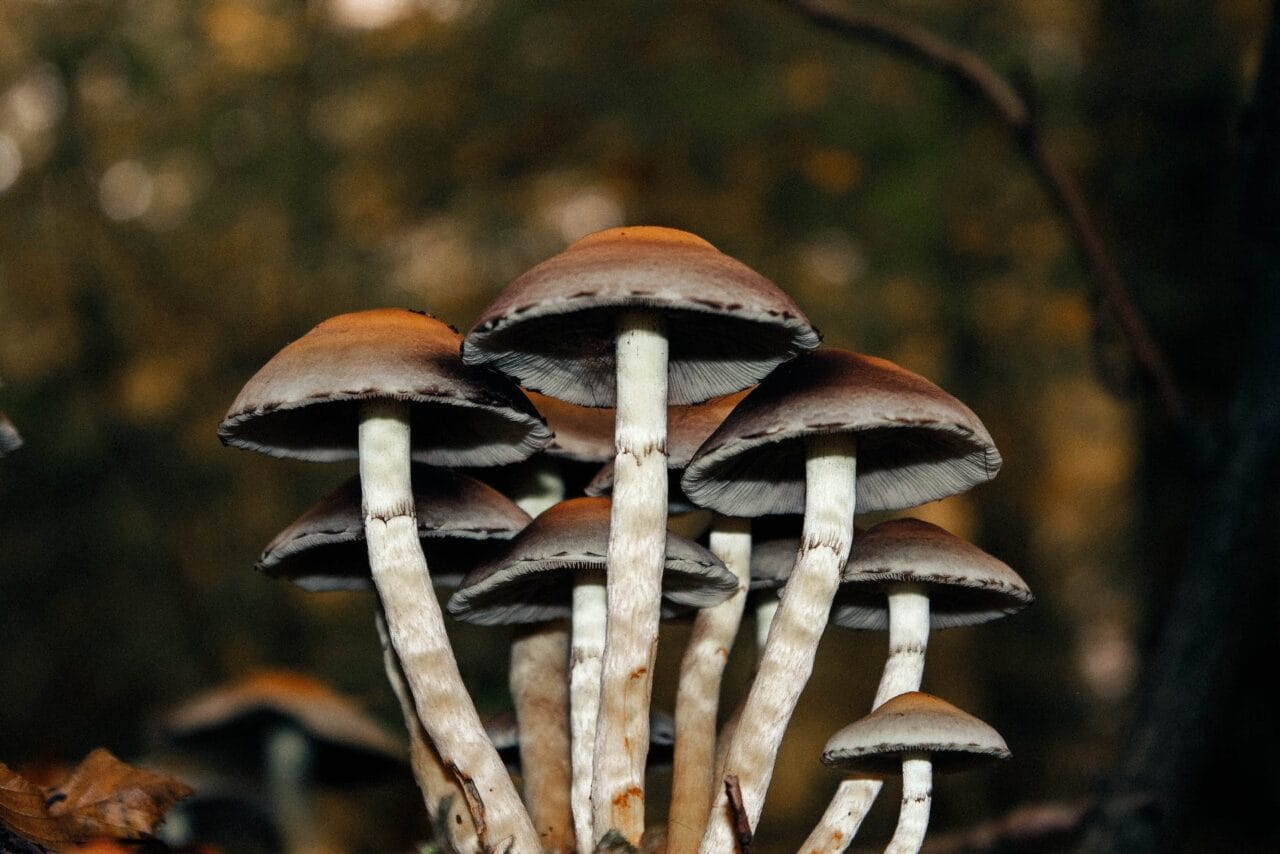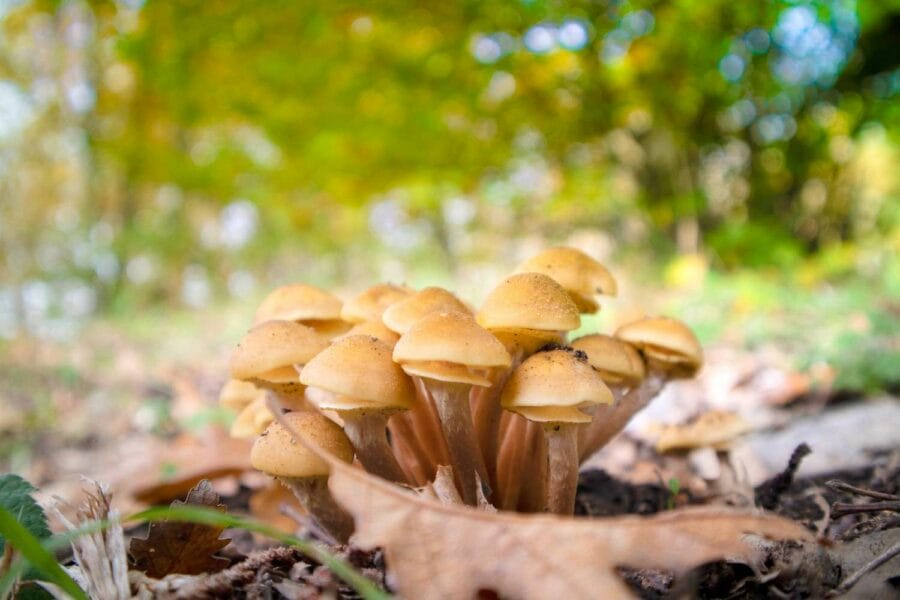Psilocybin is a psychoactive compound discovered in magic mushrooms, frequently used for recreational purposes to induce euphoria and hallucinations.
Beyond its mind-altering effects, researchers have studied the compound’s potential benefits for providing relief from chronic pain.
In this article, we delve into a case study that investigates how microdosing mushrooms may contribute to alleviating chronic pain.
Key Takeaways:
- Microdosing mushrooms could potentially provide both immediate and sustained relief from pain.
- Relative to traditional pain medications, psilocybin microdosing is typically devoid of side effects when used in small quantities.
- Psilocybin interacts with the serotonin 2A (5-HT2A) receptors to help alleviate pain, among other conditions.

The Study
The research entitled “Microdosing Psilocybin for Chronic Pain: A Case Series” was carried out by Dr. Matthew Lyes and his team at the Division of Pain Medicine, Department of Anesthesiology, University of California, San Diego. Their study revolved around three patients who self-administered minimal doses of psilocybin to manage their chronic pain symptoms.
Three Patients, One Result – Chronic Pain Relief
Patient # 1
| AGE/ GENDER: | 37 Male |
| TYPE OF PAIN: | Neuropathic pain experienced below the site of a spinal cord injury. |
| PAIN LEVEL: | Initially 4 to 5/ 10, escalating to 8/ 10 later in the day |
| PSILOCYBIN DOSE: | 250 mg of ground mushroom for less than 6 months |
| RESULT: | Discontinuation of prescribed pain medication, reduction in muscle spasms, and improved bowel movement efficiency. No signs of rebound pain or withdrawal symptoms. |
| The patient reported that while his regular medications only managed to dull the pain, psilocybin effectively eliminated it, reducing his average pain level from 5 to 0. | |
Case Study: Subject #2
| AGE/GENDER: | Female, 69 years old |
| PAIN TYPE: | Complex Regional Pain Syndrome (CRPS) |
| PAIN INTENSITY: | Usually varies from 5 to 7 on a scale of 10, but amplifies with physical activity and during pain peaks |
| PSILOCYBIN DOSAGE: | Daily consumption of 500 mg for 7 to 10 days, followed by rest periods (2 to 3 days) over a year. Dosage escalates to 750 mg to 1 gram during pain peaks |
| RESULTS: | 80% decrease in pain for 3-4 hours, gradually reverting to initial levels after 12 hours. Complete pain relief (90%-100%) persists for 6-8 hours, reverting to initial levels after 18 hours. |
| The subject shows a reduction in appetite without any feeling of nausea. Disorientation or instability in walking is observed when the dosage is increased (750 to 1000mg). | |
Case Study: Subject #3
| AGE/GENDER: | Female, 40 years old |
| PAIN TYPE: | Lumbar radiculopathy and neuropathic pain |
| PAIN INTENSITY: | 8 out of 10, surges to 10 out of 10 during physical activity |
| PSILOCYBIN DOSAGE: | 1000 mg from a mushroom chocolate bar every two months. |
| RESULTS: | Significant pain relief without any psychoactive side effects. Increased flexibility and functionality noted. Pain gradually returns to initial levels over a span of 2-4 weeks. Repeated dosing aids in better pain management. |
| The subject does not experience any significant physical, cognitive, or behavioural side effects. Her emotional state remains largely consistent. She maintains her standard dosage of her SSRI for managing depression throughout the psilocybin treatment phase. | |
Deciphering Pain Management with Psilocybin
Continuous signals of somatic and visceral pain reinforce specific neural pathways due to peripheral and central sensitization, resulting in a chronic perception of pain both physically and emotionally. Psychedelics like psilocybin activate 5-HT2A receptors, which could reset the brain regions associated with neuropathic conditions.
A subject reported enduring pain relief for several weeks. This suggests that direct stimulation of the 5-HT2A receptors could lead to a central regulation in the perception of pain and
This reflects the neuron’s capacity for change and modification.
Potential Adverse Effects of Psilocybin Versus Traditional Painkillers
| PSILOCYBIN (As Per Research) | TRADITIONAL PAIN RELIEVERS |
| Muscle spasms | Nausea |
| Decreased appetite | Stomach discomfort |
| Confusion | Headaches |
| Impaired gait | Dependency |
| No mood changes | Drowsiness |
Potential Areas for Future Psilocybin Research
Based on the experiences of three individuals, the research team identified several research areas that could be beneficial and warrant further investigation.
- Small quantities of psilocybin may provide immediate and possibly enduring relief from neuropathic pain without leading to physical dependence or addiction.
- Research into the impacts of combining various treatments with psilocybin. For example, patient #3 reported improved pain relief when psilocybin was used in conjunction with physical therapy.
- Even without the involvement of psychotherapy, small doses of psilocybin may offer pain relief, as demonstrated in this case study. The researchers propose that the inclusion of therapeutic guidance could potentially enhance or prolong the therapeutic effects.
Constraints of the Study
While the outcomes for the patients look promising, the study’s recognized limitations should be taken into account.
- The small number of participants may not represent the broader population suffering from neuropathic pain.
- The study did not involve any subjects who did not respond to psilocybin.
- There were no assessments conducted before and after the treatment to evaluate the impact of psilocybin on psychiatric conditions such as depression and anxiety.
- Most of the data was self-reported by the participants.
- The presence of the interviewer and potential bias associated with psilocybin may have influenced the participants’ responses.
- The study did not investigate the potential influence of the placebo effect.
- The study did not measure the psilocybin content in each mushroom.
Utilizing Mushrooms for Microdosing
In the referenced study, patients #1 and #2 consumed a microdose of psilocybin, sourced from dried mushrooms and ground into powder, while patient #3 combined it with chocolate. There are numerous products specifically crafted for psilocybin microdosing, and we’ve gathered a selection of them below.
Dehydrated Mushrooms
Although the study did not mention the particular strain used, the following strain is often recommended for beginners.
- Golden Teacher: This strain is one of the most prevalent and frequently encountered types of magic mushrooms.
- Amazonian Cubensis: Renowned for user-friendliness and potential cognitive enhancements.
- Cambodian: Microdosing with Cambodian cubensis mushrooms can boost focus, social awareness, and mood.
Microdose Capsules
- Euphoria Psychedelics – Micro Calm Capsules: This concoction contains Ashwagandha, Reishi, CBD, Valerian root, and Psilocybin Mushrooms, all of which are scientifically validated to alleviate anxiety and stress.
- Ground Sounds – Microdose Capsules – Champion Lover: This attractive blend presents three dosage choices: 50mg, 100mg, or 250mg of pure psilocybin combined with reishi, cacao, cordyceps, and maca.
- Kind Stranger – Brighten Capsules 250mg: These capsules feature the Golden Teacher strain, known to promote clarity, enhance creativity, and improve focus.
Psilocybin for Pain Relief
While studies on the pain-relieving capabilities of mushrooms are still ongoing, anecdotal reports and preliminary case studies are showing promise.
Such instances underscore the need for additional research into the potential benefits of psilocybin, class=”wp-block-list”>
Especially in the field of chronic pain management.
Before the widespread recognition of psilocybin’s pain-relieving effects, the inspiring stories from the case study have been a source of hope for those dealing with chronic pain.
Frequently Asked Questions
What are the effects of microdosing psilocybin?
Psilocybin primarily stimulates a serotonin receptor known as “5-HT2A” in the prefrontal cortex, leading to two primary impacts:
- Generation of “Brain-Derived Neurotrophic Factor” (BDNF)
- Augmented “Glutamate” transmission
Furthermore, psychedelics promote connections between brain regions that usually don’t interact. This distinct connectivity is an outcome of psychedelics’ ability to decrease the activity of the “Default Mode Network” (DMN), which is associated with various mental activities, such as daydreaming, introspection, and reflecting on the past and future.
What is the most recognized benefit of microdosing mushrooms?
Microdosing can potentially enhance mood, productivity, creativity, and concentration. Its most extensively examined benefit is its influence on mental health.
In November 2022, COMPASS Pathways, a mental health company, shared the findings of their comprehensive phase 2b trial, a randomized and double-blind study. Their research indicated that a single dose of psilocybin resulted in substantial reductions in depressive symptoms compared to a placebo. Participants who received a higher dose of 25 milligrams indicated a prolonged antidepressant response at the twelve-week follow-up.
A study published in the Psychiatry Research Journal suggested that psilocybin is more effective than traditional antidepressant treatments.
How do you determine your dosage?
Start with a 0.1-gram dose of psilocybin mushrooms on the first day. If the desired effects are not achieved, you can incrementally increase your dose by 0.05 grams on subsequent microdosing days until you find your ideal level.
Those with a history of using psychotropic substances may need to increase the dose to 0.5 grams to achieve the desired effects.
What steps should be taken before consuming mushrooms?
class=”wp-block-list”>What is the suggested frequency for using microdoses of mushrooms?
Several established protocols recommend structured microdosing schedules for psychedelics. These protocols primarily vary in the number of “off” days they incorporate, which are the days you abstain from microdosing.
The most popular protocols recommend including 1-3 rest days between microdoses. This aligns with the body’s natural tolerance mechanisms. The three protocols being discussed in this context are the Fadiman Protocol, the Stamets Stack, and intuitive microdosing.




